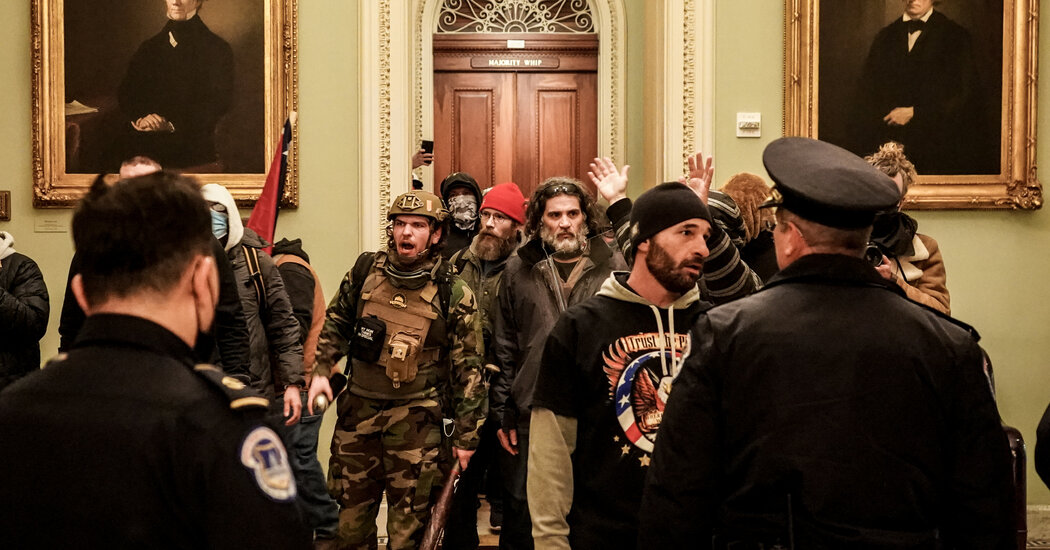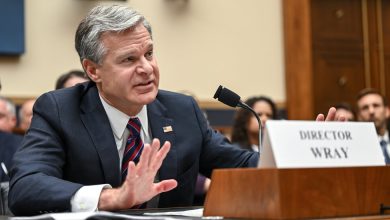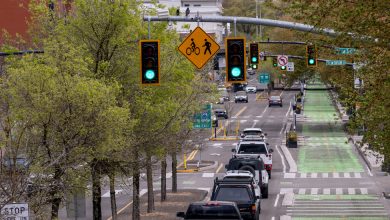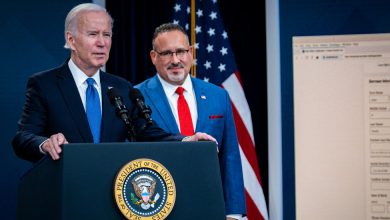Warnings From Authors Who Track Domestic Extremism

It is rare that a chill runs down my spine when I’m interviewing someone. But that’s precisely what happened when I spoke recently with Luke Mogelson and Andy Campbell, the authors of two new books on homegrown extremism and the threat it poses to American democracy.
Mogelson, a staff writer for The New Yorker, wrote “The Storm Is Here,” a visceral narrative work chronicling the rise of the movement that played a large part in the assault of the Capitol on Jan. 6, 2021.
And Campbell, a reporter for HuffPost, just published a book on the pro-Trump extremist group the Proud Boys, the product of several years of tracking them at rallies, school board meetings and street brawls across the country.
Neither Mogelson nor Campbell knew I was speaking with the other. But both authors urgently wanted to convey the same message to law enforcement officials and to the country at large: The worst is yet to come.
This week, former President Donald Trump warned in a radio interview of “big problems” if he is indicted over his handling of classified documents, comments widely interpreted as a threat to stoke violent unrest. Election officials across the country have faced so much online vitriol that hundreds of lower-level officials have quit their positions out of fear for their safety.
But the climate of menace goes well beyond elections, Campbell said.
“I really do believe that, going forward, it’s not just going to be MAGA rallies. It’s not just going to be political violence at Proud Boys rallies or leftist rallies or B.L.M. events,” he said. “It’s going to be political violence at any civic event that happens to fall in the cross hairs of Donald Trump and company.”
‘Rapidly mutating’ right-wing movements
Before writing his book, Mogelson spent much of the previous decade living and reporting abroad in conflict zones like Afghanistan. He witnessed a mob killing of someone in Iraq, which gave him an understanding of what he called the “intoxicating” feeling that can whip a crowd of seemingly ordinary people into a frenzy.
“There were elements of Jan. 6 that reminded me of that,” he said, citing “the performative aspect” of the crowd’s expressions of anger.
When he began reporting on anti-lockdown groups that mobilized against the pandemic measures put in place by governors like Gretchen Whitmer of Michigan, a Democrat, he immediately saw that the story was much larger.
“I was kind of taken aback by some of those images,” Mogelson recalled — particularly in Michigan, an open-carry state where, in April 2020, gunmen wielding military-style rifles rushed the State Capitol in Lansing to protest the coronavirus precautions.
“I soon realized that these groups and this movement was rapidly mutating,” he said.
Over the next year, he traced their evolution from an anti-lockdown movement to one that opposed the racial-justice protests in the summer of 2020 to what he called “a violent uprising against the government” on Jan. 6.
By that point, Mogelson had come to recognize many of the same people at different way stations along his reporting journey.
“It was literally the same groups and individuals that I met in April 2020,” he said.
The common thread between the seemingly disparate events he covered, Mogelson found, was “a sense of dispossession.” His subjects’ rage might be a response to feeling that their heritage was being taken away by racial minorities or immigrants or the sense that powerful forces in the government and in big technology companies were trying to steal their right to free speech.
To blend in with the mob that had responded to then-President Trump’s summons to “stop the steal,” he wore a baseball cap and a neck gaiter on the lower half of his face.
“I definitely wasn’t raising my hand on Jan. 6 telling people I was a journalist,” he said, though he kept his credentials on hand.
He followed the crowd assembled on the Ellipse in front of the White House, where Trump called on his supporters to “fight like hell” as they marched down Pennsylvania Avenue.
By the time Mogelson made it to the West Front of the Capitol Building, a contingent of Proud Boys was already inciting the broader contingent of protesters to knock over the flimsy barriers the police had hastily erected.
Mogelson saw fistfighting and blood all over the stone slabs leading up to the entrance, and he followed the crowd into the Senate. Some of the footage, he said, became evidence used in the House Select Committee’s investigation.
The Capitol riot was a traumatic event for the lawmakers caught inside the complex as the crowd marauded through hallways and up and down the marble staircases, breaking windows, drawing graffiti on historic statues and threatening the lives of members and even Vice President Mike Pence.
Representative Dean Phillips, a Democrat from Minnesota who was caught in the House Gallery as the rioters tried to break into the chamber, said in an interview that it was “the worst day of my life.” He still keeps the gas mask he wore that day on a shelf in his office as a reminder, he said, of what he sees as the stakes of free and fair elections.
But for the rioters themselves, Mogelson said, it was exhilarating.
At the Capitol on Jan. 6, he said, there was a “wild, almost joyous atmosphere of victorious celebration and catharsis.”
Why it’s hard to crack down on extremist groups
Campbell, who has been following the Proud Boys since 2017, said that his book was intended to serve as “a warning shot” to the American public.
“I wanted it to be a primer for the average person,” he said, noting how extremist groups like the Proud Boys had insinuated themselves into democratic functions like school board meetings.
“They’re latching on to political forces and giving themselves legitimacy through that,” he said.
Underscoring the point, members of Congress and administration officials complain of being hamstrung by a lack of authority to pursue members of groups like the Proud Boys, who often operate in a nebulous zone, taking advantage of freedom of speech and assembly as they build support and win political allies.
In the United States, it is not illegal to be a part of a domestic extremist group. To go after specific threats, the government has limited tools, meaning that federal officials often must find links to groups overseas in order to crack down on homegrown extremists or prosecute them under other provisions of law.
Complicating matters, Republican politicians like Trump — who instructed the Proud Boys to “stand back and stand by” during a presidential debate in 2020 — often provide rhetorical cover.
It has become a regular talking point in G.O.P. campaigns, for instance, to accuse the Justice Department of seeking to inhibit parents of school-age children from expressing themselves at school board meetings. But those applause lines actually refer to the Justice Department’s response to the way extremist groups have conducted themselves in those venues — showing up armed, in some cases, or shouting down school officials and parents they oppose.
“The Republican Party seems to not know what to do,” Campbell said.
He added, “It seems like their inability to rebut the Proud Boys and other extremists is pushing this machine forward so much faster and really making it hard for law enforcement to keep up.”
What to read on democracy
-
During a summit meeting at the White House on Thursday, President Biden denounced white supremacy and called on Americans to speak out against prejudice, Peter Baker writes. “In America, evil will not win, will not prevail,” the president said. “And white supremacists will not have the last word.”
-
Cecilia Kang profiled Catherine Engelbrecht, a Texas small-business owner turned election-fraud crusader who has sown doubts about ballots and voting.
-
A review by The New York Times of some 400 voting-fraud charges filed in the U.S. since 2017 underscored what critics of fraud crackdowns have said: Prosecutions were rare, and they often netted people who didn’t realize they were breaking the law, Michael Wines writes.
-
With cameras, plexiglass and fireproofing, election officials across the U.S. are beefing up security as violent rhetoric intensifies, Neil Vigdor writes.
Viewfinder
Capturing the House’s newest member
On Politics regularly features work by Times photographers. Here’s what Haiyun Jiang told us about taking the image above:
When I arrived at the Rayburn Room in the Capitol for a ceremonial swearing-in held by Speaker Nancy Pelosi for the member-elect Mary Peltola, a Democrat and the first Alaska Native elected to Congress, most of the wire photographers took a spot front and center.
Instead, I picked a spot on the side that allowed me to capture Peltola’s arrival and departure. After the photo op, I quickly exited the room and waited for her to come out, then took this shot.
I could sense the joy of a newly minted member of Congress, the pride of the people she represents, yet a bit of uneasiness around the press.
Thank you for reading On Politics, and for being a subscriber to The New York Times. — Blake
Read past editions of the newsletter here.
If you’re enjoying what you’re reading, please consider recommending it to others. They can sign up here. Browse all of our subscriber-only newsletters here.
Have feedback? Ideas for coverage? We’d love to hear from you. Email us at [email protected].




